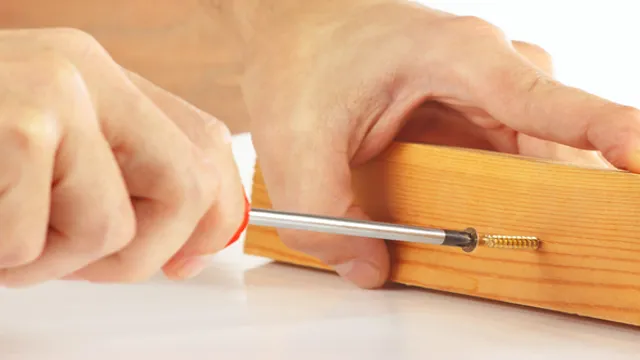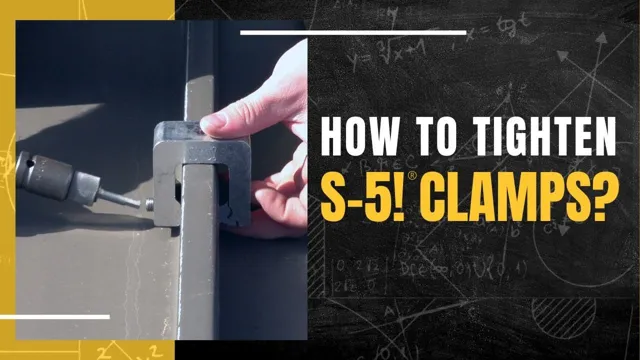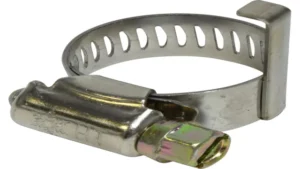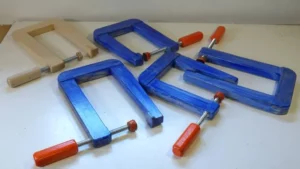Have you ever found yourself pondering over the question of how tightly you should tighten your exhaust clamps? As a car enthusiast, it’s important to know how to properly tighten your exhaust clamps to prevent leaks and ensure optimum performance. The truth is, there isn’t a one-size-fits-all answer to this question as it largely depends on the type of clamp you have installed and the materials used for your exhaust system. However, there are some general guidelines that you can follow to ensure your exhaust clamps are tightened to the right degree, without causing damage or leaks.
In this blog, we’ll provide an in-depth insight on how to tighten your exhaust clamps, so you can get the most out of your car’s performance.
Factors to Consider
When it comes to tightening exhaust clamps, there are a few factors you’ll want to consider to ensure a secure and proper fit. First and foremost, you’ll want to make sure that the clamp is tight enough to prevent any leaks, but not so tight that it damages the pipes or causes them to warp. It’s a delicate balance that may require some trial and error.
You’ll also want to consider the type of clamp you’re using – some require a bit more force to tighten than others. Another important factor to keep in mind is the material of the pipes themselves. If you’re working with older or more fragile pipes, you’ll want to take extra care to avoid over-tightening and causing damage.
At the end of the day, it’s all about finding the right balance between tightness and gentleness – and with a bit of practice, you’ll soon get the hang of it.
Material of the Exhaust System
When it comes to material for the exhaust system in your vehicle, there are several factors to consider. One important factor is the resistance of the material to corrosion and temperature changes. Stainless steel is a popular material for exhaust systems as it is highly resistant to rust and can withstand high temperatures.
Another factor to consider is weight. Materials such as titanium and Inconel are lightweight and can improve overall performance. However, they are typically more expensive.
Ceramic coatings can also be applied to exhaust systems to provide a layer of protection against heat and corrosion. Ultimately, the material you choose for your exhaust system will depend on your budget, performance needs, and driving habits. By considering these factors, you can ensure that your exhaust system will last longer and perform better.

Type of Exhaust Clamp Used
When it comes to selecting the right type of exhaust clamp for your vehicle, there are several factors to consider, and each of them is equally important. The first thing to consider is the size of your exhaust system. You need to measure the circumference of your pipe so that you can choose the right size clamp.
You also need to consider the type of material used to make the clamp. Stainless steel is a popular choice as it offers excellent corrosion resistance, which is especially important if you live in areas where salt is used to melt ice on the roads. Another factor to consider is the design of the clamp.
Some designs use U-bolts, while others use band clamps. U-bolt clamps are generally stronger and offer better sealing, while band clamps are easier to install and remove. Ultimately, the choice of exhaust clamp will depend on your specific needs, but by considering the factors mentioned above, you can make an informed decision that will provide a secure and long-lasting connection between your exhaust components.
Manufacturer’s Recommendations
When it comes to choosing the right type of oil for your vehicle, it’s essential to follow the manufacturer’s recommendations. These recommendations take into consideration various factors specific to your car, such as its age, mileage, and usage. Additionally, following these recommendations also ensures that your car’s warranty remains valid.
One of the primary factors to consider is the type of engine your car has. Some engines require full synthetic oil, while others can use conventional or synthetic blends. It’s also necessary to consider the oil’s viscosity rating, which determines its thickness and how well it can flow through the engine parts.
If your car operates in extreme temperatures or has special towing requirements, you may need an oil with a higher viscosity rating. Another important factor to keep in mind is the oil change interval. It’s tempting to ignore the recommended oil change frequency and stretch out the time between changes, but doing so can result in engine damage and added repair costs.
Lastly, it’s vital to use high-quality oil and replace the oil filter during every oil change. By following the manufacturer’s recommendations for oil type, viscosity rating, and oil change frequency, you can help ensure your car runs smoothly and avoid costly repairs. Remember, it’s better to keep up with routine maintenance than to incur the expense and hassle of a breakdown on the road.
Tools Required to Tighten Exhaust Clamps
When it comes to tightening exhaust clamps, there are a few essential tools that you’ll need to have on hand. Firstly, a proper socket wrench set will do the trick. You’ll want to make sure the wrench fits the size of the clamps you’re working with, as well as the bolts that hold them in place.
In addition to the wrench, you’ll also want to have a torque wrench. This tool helps you measure the amount of force you’re applying to the clamps, ensuring that you don’t over-tighten or under-tighten them. As for the question of how tight to make the clamps, the answer is relatively straightforward.
You’ll want to tighten them enough so that they’re secure and don’t allow for any air leaks, but not so tight that you damage the clamps or the exhaust pipe. A good rule of thumb is to tighten the clamps to the point of resistance and then give them one or two additional turns until they’re snug. Remember, over-tightening can be just as harmful as under-tightening, so it’s important to strike the right balance.
With the right tools and a little bit of care, you can ensure your exhaust clamps stay secure and effective for miles to come.
Socket Wrench
When it comes to tightening exhaust clamps, having the right tools can make all the difference. One of the essential tools you’ll need is a socket wrench. A socket wrench is a versatile tool with a ratcheting mechanism that allows you to tighten or loosen nuts and bolts quickly and efficiently.
It typically comes with different sized socket attachments that can be used interchangeably depending on the size of the bolt you’re working with. Socket wrenches are particularly useful in confined spaces where traditional wrenches wouldn’t fit or be able to turn. Make sure to choose a socket wrench set that includes the right socket sizes for your specific exhaust clamp bolts.
A socket wrench is a must-have tool in your arsenal if you plan on performing regular maintenance on your vehicle’s exhaust system.
Adjustable Wrench
When it comes to tightening exhaust clamps, having the right tools is crucial. One of the essential tools you will need is an adjustable wrench. This type of wrench allows you to adjust the jaw width to suit the size of the nut or bolt you’re working with, making it perfect for tightening exhaust clamps.
The adjustable wrench is versatile, and you can use it for other tasks in your vehicle, such as tightening or loosening bolts on your engine. When using an adjustable wrench, make sure you position it correctly on the nut or bolt and apply enough pressure to tighten it properly. With this tool in your kit, you’ll be able to tackle any exhaust clamp tightening task with ease.
So, keep an adjustable wrench at the top of your priority list if you’re looking to work on your vehicle’s exhaust system.
Torque Wrench
When it comes to tightening exhaust clamps, having the right tools can make all the difference. One of the most important tools to have is a torque wrench. A torque wrench ensures that the clamp is tightened to the correct specification, preventing leaks and potential damage to the exhaust system.
When using a torque wrench, it’s essential to use the proper torque settings as specified by the manufacturer. Over-tightening can lead to damage, while under-tightening can result in leaks. In addition to a torque wrench, it’s also useful to have a socket set, pliers, and a pry bar.
These tools can help you access and loosen tight or rusted bolts or clamps. By using the right tools for the job, you can ensure a secure and safe exhaust system, the prevention of leaks that can damage your car engine, and greater peace of mind on the road.
The Right Technique to Tighten Exhaust Clamps
When it comes to tightening exhaust clamps, it’s important to use the correct technique to ensure a secure fit that won’t cause any leaks or rattling noises. So, how tight do you tighten exhaust clamps? Well, it’s recommended to tighten them until they are snug but not over-tightened. Over-tightening can actually cause damage to the clamp or the exhaust pipe, and can even cause the clamp to break.
A good way to check if it’s tight enough is to give it a gentle tug or twist after tightening to ensure that it doesn’t move. It’s also important to make sure that the clamp’s bolt or nut is centered and tightened evenly on both sides to avoid any uneven pressure that could damage the clamp over time. By following these simple steps, you can ensure that your exhaust system stays secure and functioning properly.
Step-by-Step Guide to Tighten Exhaust Clamps
Tighten Exhaust Clamps If you’re experiencing a leaky exhaust system or some annoying noise, it may be the result of loose exhaust clamps. Tightening them is a simple procedure that can be done in just a few minutes with the right tools and technique. Firstly, it’s important to identify where the leak is coming from by inspecting the exhaust system thoroughly.
Once you’ve located the loose clamps, make sure you have the necessary tools like a ratchet wrench or a socket set. It’s also advisable to wear gloves as exhaust parts can get hot and cause burns. With the tool of your choice, tighten the clamp with firm, consistent pressure.
Avoid over tightening the clamp as it can damage it, making the problem worse. Additionally, ensure that all clamps are tightened to the same level of tension for maximum effectiveness. Regular inspection is also recommended to catch any loose clamps before they become a significant issue.
Overall, tightening exhaust clamps requires a bit of skill and the right tools, but it can save you from more expensive repairs down the line.
Importance of the Right Tightness of Exhaust Clamps
When it comes to installing or repairing your vehicle’s exhaust system, one of the most critical factors to consider is how tight you should tighten the exhaust clamps. Over-tightening or under-tightening can cause significant problems, such as leaks, damage to the components, and even vibrations. The right level of tightness can be determined by checking the manufacturer’s specifications or consulting with a trusted mechanic.
However, in general, the clamp should be tightened until it is snug enough to form a seal but not so tight that it causes deformation or warping of the metal. It may take some trial and error to achieve the perfect balance between tightness and ease of removal, but getting it right can help ensure consistent performance, reduce the risk of further damage, and, most importantly, keep you and other drivers safe on the road.
Conclusion
In conclusion, the question of how tight to tighten exhaust clamps is a bit like asking how much salt to add to your favorite recipe: it depends on the individual dish. Too little salt and the flavors fall flat, too much and you’ll have a mouthful of disappointment. The same goes for exhaust clamps – too loose and your car may sound like it’s been hit with a deflating balloon, too tight and you may risk damaging the clamps or the exhaust itself.
So, the key is finding that sweet spot, where the clamps are snug enough to keep everything in place but not so tight that they’re causing damage. It may take some trial and error before you find the right tension for your specific vehicle and exhaust system, but once you do, you’ll be on your way to a smooth and steady ride. Happy tightening!”
FAQs
What is the purpose of exhaust clamps?
Exhaust clamps are used to keep the exhaust components securely connected and prevent leaks.
How tight should exhaust clamps be tightened?
Exhaust clamps should be tightened until they are snug, but not overly tight. Over-tightening can cause damage to the exhaust components.
Can you reuse exhaust clamps?
It is not recommended to reuse exhaust clamps as they can become worn or damaged over time and may not provide a secure connection.
What are the different types of exhaust clamps?
There are various types of exhaust clamps, including band clamps, V-band clamps, U-bolt clamps, and lap-joint clamps.
Are there specific torque specifications for tightening exhaust clamps?
Some manufacturers may provide torque specifications for exhaust clamps, but in general, they should be tightened until they are snug, and then given an extra quarter turn.
Are exhaust clamps interchangeable with different exhaust components?
The size and type of exhaust clamp should match the corresponding exhaust component for an optimal fit and seal.
Can exhaust leaks be caused by loose clamps?
Yes, loose or poorly tightened exhaust clamps can result in exhaust leaks, which can lead to decreased performance and increase the risk of carbon monoxide poisoning.






